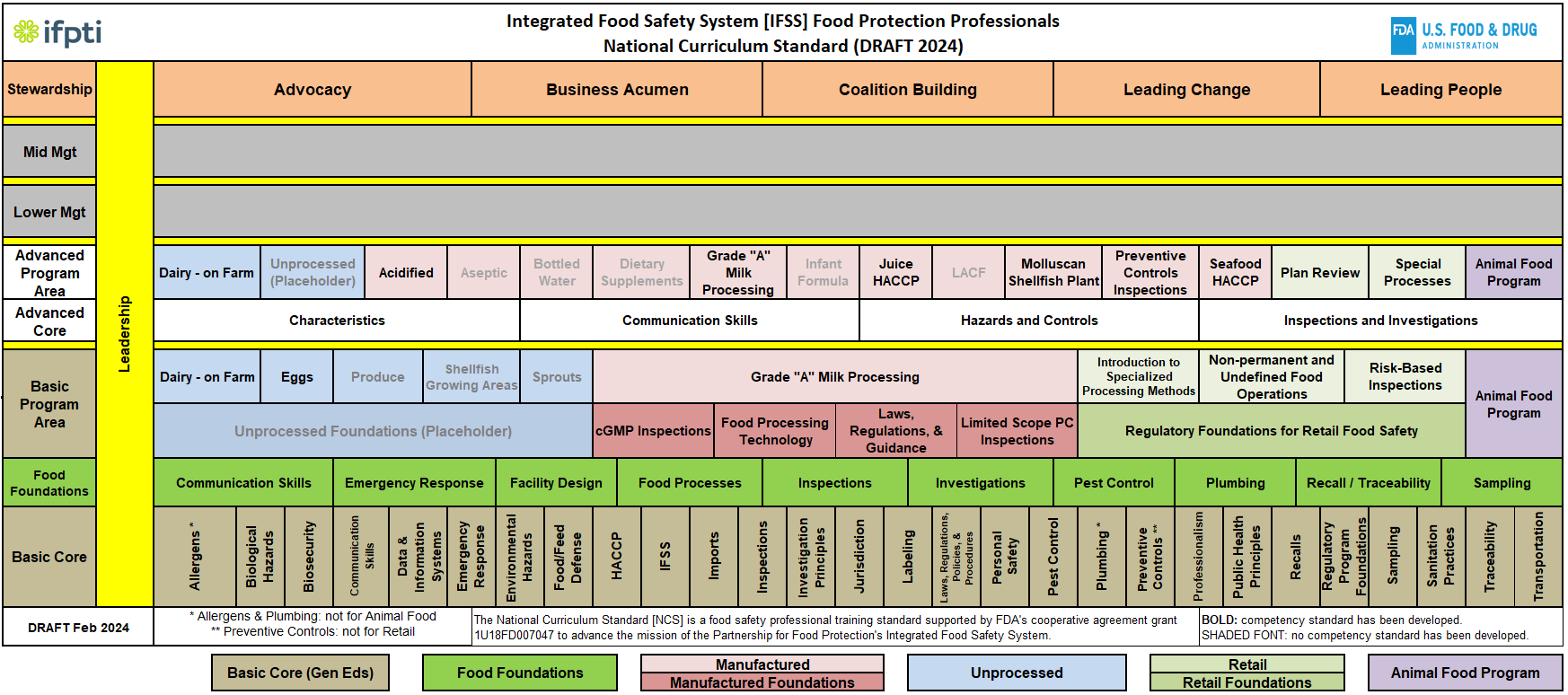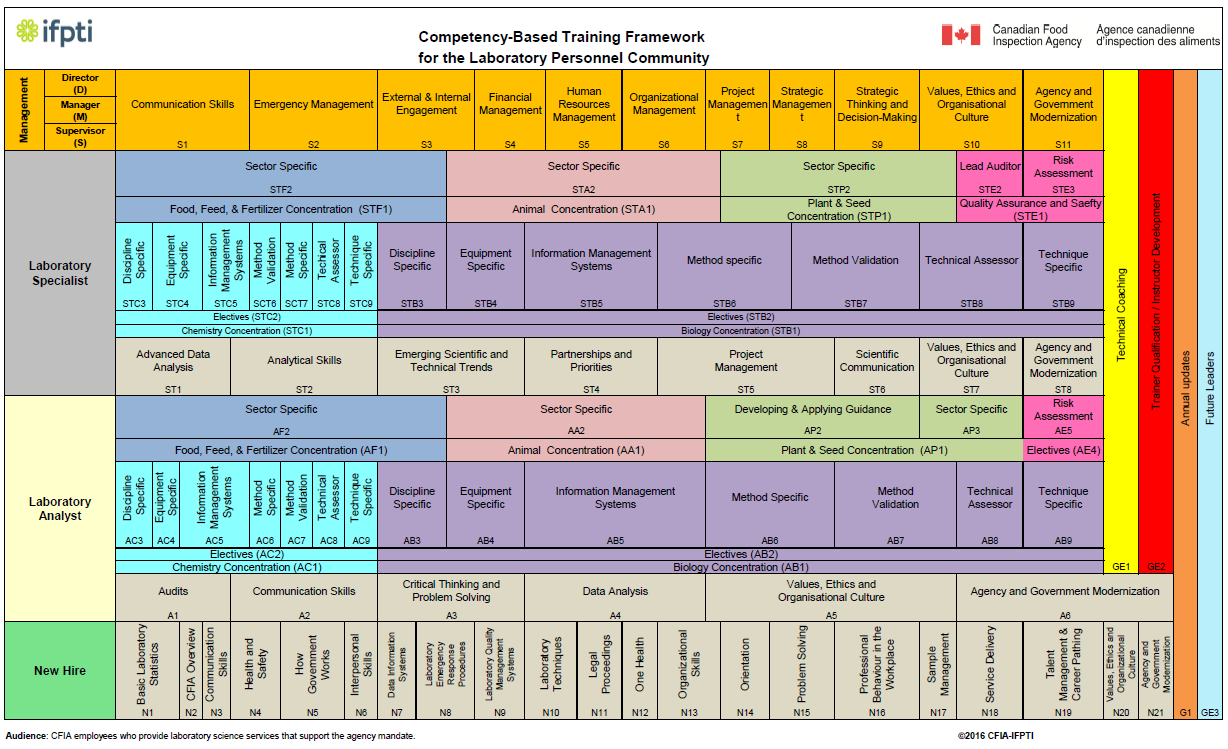National Curriculum Standard
Through a Cooperative Agreement with the US Food and Drug Administration (FDA), IFPTI is leading the development and build-out of the National Curriculum Standard (NCS). The NCS is a key element of the Integrated Food Safety System (IFSS), a seamless partnership and collaboration among human and animal food regulatory jurisdictions: Federal, State, Local, Tribal, and Territorial.
The NCS represents a national competency standard for human and animal food regulatory professionals, across their entire careers. The NCS depicts the knowledge, skills, and abilities needed by these regulators in order to successfully perform their jobs, thereby assuring a competent regulatory workforce doing comparable work across all jurisdictions.
The IFSS Frameworks are key components of the NCS. An IFSS Framework is a color-coded schematic of the human and animal food regulatory profession, demonstrating the interrelationship between and among professional career levels, program areas, and content or topic areas. A Framework is a living, breathing document, and is consistently being revised and updated as buildout of the Framework continues.
Click on a completed topic in the interactive Food Protection Professionals framework below to view the associated competencies and learning resources.
View IFSS Human and Animal Food Laboratory Framework
The NCS serves multiple purposes, including:
1. Training Design and Development: the NCS provides the objectives for training and course design. For example, the IFSS Basic Level Courses were developed based on the NCS.
2. Evaluation: the NCS provides a standard against which existing courses and training materials can be evaluated.
3. Assessment: the NCS provides a standard for self-assessment and supervisory assessment for coaching and mentoring.
4. Career Path Development: the NCS provides a “map” for human and animal food regulatory professionals’ career development.
5. Staffing Practices: the NCS provides a standard for hiring, onboarding, developing job descriptions, and creating training plans.
6. Open-Source Catalog: existing training materials and related resources can be arranged and categorized according to the NCS.
7. The Food Protection Professionals NCS also forms the foundation for the AFDO Credential Series.
Blueprint for course development
One of the foundational processes used by training developers in the instructional systems design (ISD) field is the ADDIE model, which outlines the five steps for developing effective training. The chronological steps in the model are: Analysis, Design, Development, Implementation, and Evaluation.
When we build out a particular content or topic area within the IFSS Framework, we are essentially creating a “blueprint” for training development. Building out the content or topic area involves identifying competencies and behavioral anchors.
Taken together, the competencies and behavioral anchors provide all the details concerning what should be covered in a training course.
ISD professionals, therefore, can use these content or topic area “blueprints” and, in close collaboration with appropriate subject matter experts, can create course learning objectives (which are often modified versions of the competencies), build course content, course activities, learner interactions, and knowledge checks, all of which are recommended components of any learning event.
Looking back at the ADDIE model, then, we can see that these “blueprints” represent the Analysis and Design phases of the process. The Analysis involves identifying what the regulator needs to know or be able to do, and the Design relates to arranging the competencies and behavioral anchors into a sequenced, organized blueprint that can be utilized during the next step of the ADDIE process, the Development phase.
Cataloging system and gap analysis/inventory
The IFSS Framework is a carefully organized schematic, arranged by professional levels (Basic, Advanced, etc.), specific program areas or concentrations such as Retail Food, Manufactured Food, Unprocessed Food, and Animal Food, and focused content or topic areas tailored to each professional level.
As such, the Framework can serve as a unique, open-source system to be used by regulatory agencies at all jurisdictions, training providers, and training developers to arrange existing materials into their appropriate slot, much like a book is placed on a particular shelf in a library.
This cataloging system can be used to organize any existing training courses, guidance documents, and reference materials. Additionally, the system can help identify gaps in existing training across the US, and can help identify learning events in need of development.
Assessment against competencies
The content area “blueprints” aid in the assessment process. Remember, the blueprints comprise a set of:
competencies (knowledge, skills, and abilities) needed by regulatory professionals to successfully perform their job functions; and
behavioral anchors tailored to each competency, which are indicators that an individual can actually demonstrate the particular knowledge, skills, or ability.
Taken together, the competencies and behavioral anchors can be used by an assessor to help measures an individual’s level of competency and help identify any competency gaps that can be addressed through training, mentoring, job shadowing, or field experience. For example, an individual can conduct a self-assessment to determine if he or she possesses competencies necessary at a particular career level, and can use the results of the self-assessment to determine their progress within a particular career path.
Additionally, a supervisor or manager can assess an entire staff against a set of competencies, to help determine if any new or refresher training is warranted.





